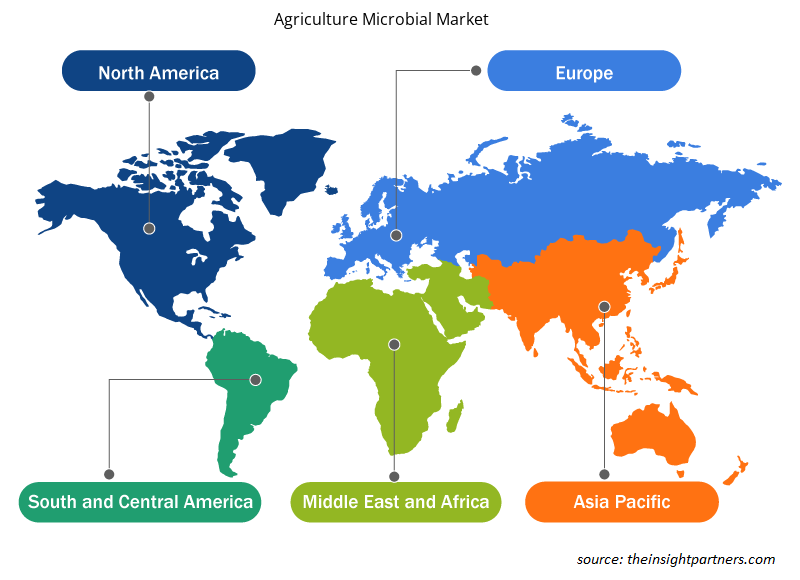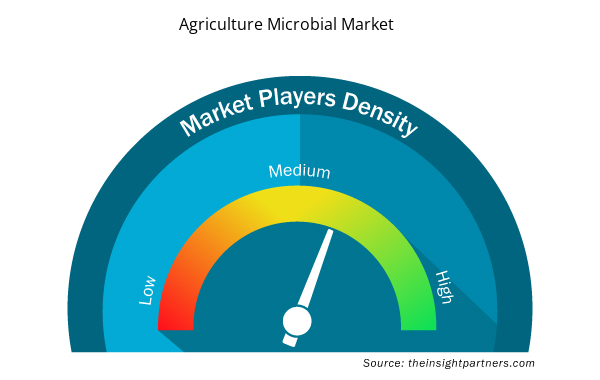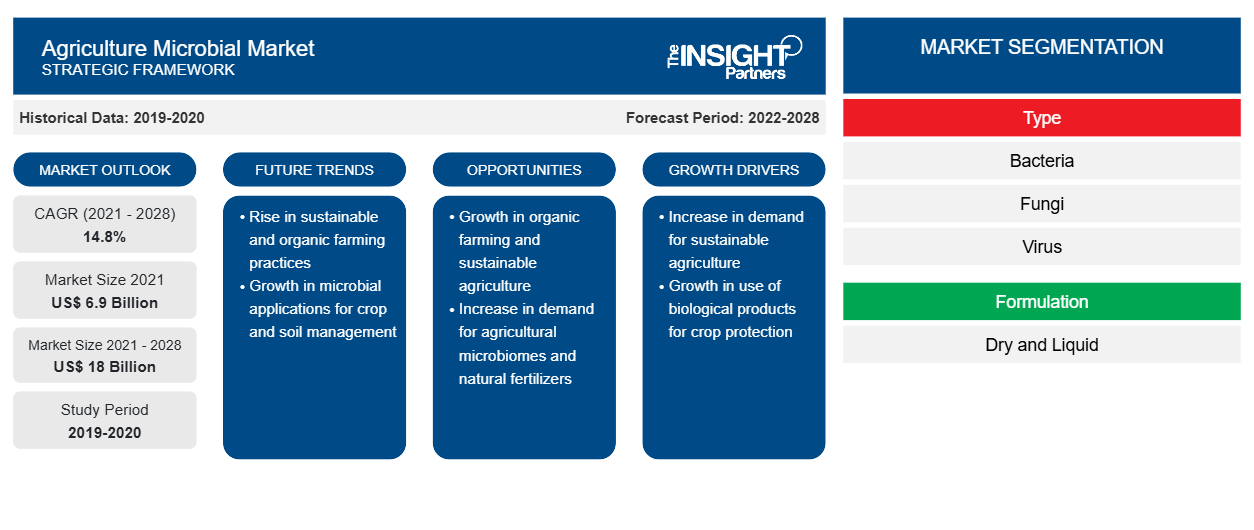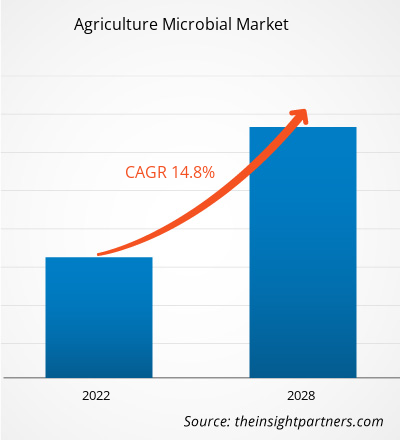Insight Partners에 따르면 농업 미생물 시장은 2021년에 6,901.93백만 달러 규모로 평가되었으며 2022년부터 2028년까지 연평균 성장률 14.8%로 성장할 것으로 추산됩니다.
농업 미생물은 작물 생산성과 수확량 품질을 높이기 위해 농업에서 사용되는 미생물을 말합니다. 박테리아, 곰팡이, 바이러스는 몇 가지 미생물입니다. 이들은 보충제에 대한 접근성을 개선하여 식물의 성장을 촉진할 수 있습니다. 많은 미생물은 유기물을 분해하고 농업 폐기물을 재활용하는 데 도움이 됩니다. 또한 인, 질소 및 기타 영양소를 제공하고 열 및 가뭄 내성과 곤충 및 식물 질병에 대한 저항성을 포함한 이점을 제공합니다.
2020년에 북미는 글로벌 농업 미생물 시장 에서 가장 큰 점유율을 차지했으며 아시아 태평양은 예측 기간 동안 가장 높은 CAGR을 기록할 것으로 추정됩니다. 북미는 합성 화학 물질보다 농업에서 미생물을 사용하는 이점에 대한 인식이 높아짐에 따라 시장에서 가장 중요한 지역 중 하나입니다. 합성 화학 물질은 해충 저항성을 개발하고 작물 생산에 해를 끼치기 때문에 사용은 효과가 없습니다. 농업 미생물은 소량으로 적용하더라도 실용적이고 분해가 빠르기 때문에 노출이 적고 합성 화학 물질로 인한 환경 문제를 방지합니다.
게다가 친환경 및 유기농 농업 관행의 증가는 미생물 농업 시장의 성장을 촉진합니다. 미국 농무부(USDA)의 2019년 유기농 조사에 따르면, 2019년 미국은 16,585개의 유기농 농장을 보유하고 있었으며, 이는 2016년 대비 16.7% 증가한 수치입니다.
귀하의 요구 사항에 맞게 이 보고서를 사용자 정의하세요
이 보고서의 일부 또는 국가 수준 분석, Excel 데이터 팩을 포함하여 모든 보고서에 대한 사용자 정의를 무료로 받을 수 있으며 신생 기업 및 대학을 위한 훌륭한 혜택과 할인 혜택을 이용할 수 있습니다.
- 이 보고서의 주요 시장 동향을 알아보세요.이 무료 샘플에는 시장 동향부터 추정 및 예측까지 다양한 데이터 분석이 포함됩니다.
COVID-19 팬데믹이 농업 미생물 시장에 미치는 영향
COVID-19 팬데믹 이전에 농업 미생물 시장은 주로 유기농 농업의 채택 증가와 지속 가능한 농업에 대한 수요 증가에 의해 주도되었습니다. 그러나 많은 산업이 2020년 팬데믹으로 인해 전례 없는 어려움에 직면했습니다. 농업 산업은 여러 제조 단위의 폐쇄와 공급망의 중단으로 인해 감소했습니다. 그러나 2021년에 정부가 이전에 부과된 제한을 완화한다고 발표하면서 다양한 경제권이 운영을 재개했고, 이는 글로벌 시장에 긍정적인 영향을 미쳤습니다. 게다가 제조업체는 최대 용량으로 운영할 수 있게 되어 수요와 공급 격차를 극복하는 데 도움이 되었습니다. 현재 시장 상황은 이전보다 훨씬 나아졌습니다. 많은 국가가 완전히 예방 접종을 받았으며 농업 미생물 제품 제조업체는 수익을 늘리기 위해 생산량을 늘리는 데 주력하고 있습니다.
제조 단위의 노동력 부족과 이후 봉쇄와 매장 폐쇄로 인해 유통업체와 소매업체를 통한 현장 판매 중단으로 농업 미생물 시장이 제약을 받았습니다. COVID-19 팬데믹으로 인해 큰 타격을 입었음에도 불구하고, 여러 회사에서는 2020년 말까지 지속 가능한 농산물에 대한 수요가 증가했다고 보고했습니다. 그러나 농산물 부족이 심화됨에 따라 다양한 정부가 식량 수요를 충족하기 위해 농산물에 대한 제한을 완화했습니다.
시장 통찰력
유기농 농업 채택 증가로 농업 미생물 시장이 성장
지난 몇 년 동안 유기농 농업은 지속 가능성을 달성하고 환경에 미치는 해로운 영향을 줄이기 위해 전 세계적으로 채택되었습니다. 토양 침식 감소, 지하수 및 표면수로의 질산염 침출 감소, 농장에서의 재활용 동물 배설물 사용은 유기농 농업의 이점 중 일부입니다. 이점에 대한 인식이 높아짐에 따라 유기농 농업 관행에 대한 수요가 급증했습니다. 미국 농업 통계청이 실시한 2019년 유기농 조사에 따르면 미국에서는 2016년과 2019년 사이에 인증된 유기농 농장이 17% 증가했습니다. 유엔 식량 농업 기구(FAO)에 따르면 2019년에 유기농 농업은 187개국에서 실시되었으며 약 7,230만 헥타르의 농경지가 유기농으로 관리되었습니다. 개발도상국의 여러 정부는 유기농 농업 채택을 강력히 강조합니다. 농업 미생물은 합성 성분으로 대체할 수 없기 때문에 토양 관리를 위한 유기농 농업에서 중요한 역할을 합니다. 박테리아, 균류, 바이러스를 포함한 토양 미생물은 작물 잔여물 분해, 질소 및 탄소와 같은 필수 영양소 순환, 식물 성장 자극과 같은 토양에서 기본적인 기능을 수행합니다. 따라서 유기농 농업의 채택 증가는 유기농 농업에서의 이점으로 인해 농업 미생물에 대한 수요를 촉진합니다.
유형 통찰력
농업 미생물 시장은 유형에 따라 박테리아, 균류, 바이러스 및 기타로 세분화됩니다. 박테리아 부문은 예측 기간 동안 가장 큰 시장 점유율과 가장 높은 CAGR을 유지할 것으로 예상됩니다. 균류는 유기물을 분해하고 폐기물 식물 재료를 재활용하는 데 필수적인 토양 미생물 중 하나입니다. 또한 물 역학, 영양소 순환 및 질병 억제와 관련된 필수 기능을 수행합니다. 예를 들어, 균류 균사는 토양 입자와 물리적으로 결합하여 안정적인 응집체를 생성하여 식물의 토양 수분 보유 용량과 물 침투를 증가시키는 데 도움이 됩니다.
제형 통찰력
제형에 따라 농업 미생물 시장은 건조 및 액상으로 구분됩니다. 액상 세그먼트는 예측 기간 동안 더 큰 시장 점유율을 차지할 것으로 예상되는 반면, 건조 세그먼트는 2021년부터 2028년까지 더 높은 CAGR을 기록할 것으로 예상됩니다. 액상 세그먼트 시장은 적용이 용이하기 때문에 성장하고 있습니다. 제품의 액상 제형은 농업 미생물의 건조 형태보다 더 편리합니다. 왜냐하면 관주, 살포 및 뿌리 딥으로 직접 사용할 수 있기 때문입니다. 또한 혼합과 같은 추가 절차가 필요하지 않아 제품의 부패와 낭비를 방지하는 데 도움이 됩니다.
기능 통찰력
기능에 따라 농업 미생물 시장은 작물 보호와 토양 개량제 로 나뉩니다 . 작물 보호 부문은 2020년에 더 큰 시장 점유율을 차지했습니다. 농업 미생물은 뿌리, 씨앗, 과일 및 작물의 다른 부분을 보호하는 데 사용할 수 있습니다. 작물 보호 제품은 더 작은 면적의 생산 증가, 환경 보호, 더 높은 수확량 및 낮은 식품 비용을 포함한 다양한 이점을 제공합니다. 이러한 이점은 작물 보호 제품의 채택을 증가시켰습니다. 미생물 해충 방제는 생태학적 안전성과 상당한 양의 표적 특이성을 제공하므로 해충 관리 방제 프로그램이 선호됩니다.
응용 프로그램 통찰력 모드
적용 방식에 따라 농업 미생물 시장은 엽면 살포, 토양 처리, 종자 처리 및 수확 후로 세분화됩니다. 엽면 살포 세그먼트는 2020년에 가장 큰 시장 점유율을 차지했습니다. 엽면 살포를 통해 적용된 영양소는 다른 기술을 통해 적용된 영양소보다 더 빨리 흡수됩니다. 엽면 살포를 사용하면 노동 및 기계 비용을 줄이는 데 도움이 되어 작물 생산 비용을 최소화할 수 있습니다. 이러한 기술은 식물의 결핍 및 질병에 대한 신속한 교정 치료 역할을 합니다.
작물 유형 통찰력
작물 유형에 따라 농업 미생물 시장은 곡물 및 곡물, 유지종자 및 콩류, 과일 및 채소, 기타로 세분화됩니다. 과일 및 채소 부문은 2020년에 가장 큰 시장 점유율을 차지했습니다. 이 부문의 시장 성장은 작물과 관련된 높은 보수 요인과 필수 영양소를 효과적으로 제공하려는 수요 증가에 기인합니다. 또한 유기농 과일 및 채소에 대한 수요 증가로 인해 농업 미생물에 대한 필요성이 커지고 있습니다.
BASF SE, Bayer AG, Certis USA LLC, BioWorks, Novozymes A/S, Chr. Hansen Holding A/S., Syngenta Group, Nufarm, Marrone Bio Innovations, Inc., Koppert BV는 농업 미생물 시장에서 활동하는 주요 기업입니다. 이러한 기업은 전 세계적으로 증가하는 소비자 수요를 충족하기 위해 신제품 출시와 지역 확장에 중점을 두고 있습니다. 이들은 광범위한 글로벌 입지를 갖추고 있어 전 세계의 많은 고객에게 서비스를 제공하고 결과적으로 시장 점유율을 늘릴 수 있습니다. 이러한 시장 기업은 신제품 출시와 지역 확장에 중점을 두고 특수 포트폴리오에서 제품 범위를 늘립니다.
농업 미생물 시장 지역 통찰력
Insight Partners의 분석가들은 예측 기간 동안 농업 미생물 시장에 영향을 미치는 지역적 추세와 요인을 철저히 설명했습니다. 이 섹션에서는 북미, 유럽, 아시아 태평양, 중동 및 아프리카, 남미 및 중미의 농업 미생물 시장 세그먼트와 지리에 대해서도 설명합니다.

- 농업 미생물 시장에 대한 지역별 특정 데이터 얻기
농업 미생물 시장 보고서 범위
| 보고서 속성 | 세부 |
|---|---|
| 2021년 시장 규모 | 69억 달러 |
| 2028년까지 시장 규모 | 180억 달러 |
| 글로벌 CAGR (2021-2028) | 14.8% |
| 역사적 데이터 | 2019-2020 |
| 예측 기간 | 2022-2028 |
| 다루는 세그먼트 | 유형별로
|
| 포함된 지역 및 국가 | 북아메리카
|
| 시장 선도 기업 및 주요 회사 프로필 |
|
농업 미생물 시장 참여자 밀도: 비즈니스 역학에 미치는 영향 이해
농업 미생물 시장 시장은 소비자 선호도의 변화, 기술 발전, 제품의 이점에 대한 인식 증가와 같은 요인으로 인해 최종 사용자 수요가 증가함에 따라 빠르게 성장하고 있습니다. 수요가 증가함에 따라 기업은 제품을 확장하고, 소비자의 요구를 충족하기 위해 혁신하고, 새로운 트렌드를 활용하여 시장 성장을 더욱 촉진하고 있습니다.
시장 참여자 밀도는 특정 시장이나 산업 내에서 운영되는 회사나 기업의 분포를 말합니다. 주어진 시장 공간에 얼마나 많은 경쟁자(시장 참여자)가 존재하는지 그 규모나 전체 시장 가치에 비해 나타냅니다.
농업 미생물 시장에서 운영되는 주요 회사는 다음과 같습니다.
- 바스프 SE
- 바이엘 AG
- 세르티스 USA LLC
- 바이오웍스
- 노보자임스 A/S
면책 조항 : 위에 나열된 회사는 어떤 특별한 순서에 따라 순위가 매겨지지 않았습니다.

- 농업 미생물 시장의 주요 주요 업체 개요를 알아보세요
스포트라이트 보고서
- 농업 미생물 시장의 진보적인 산업 동향은 기업이 효과적인 장기 전략을 개발하는 데 도움이 됩니다.
- 선진국과 개발도상국의 농업미생물 시장 참여자들이 채택한 사업 성장 전략
- 2020년부터 2028년까지의 시장에 대한 정량적 분석
- 세계 작업복 수요 추산
- 농업 미생물 시장에서 구매자와 공급자의 효능을 설명하기 위한 포터의 5가지 힘 분석
- 경쟁 시장 시나리오를 이해하기 위한 최근 개발
- 시장 동향 및 전망, 농업 미생물 시장 성장을 촉진하고 제한하는 요인
- 상업적 이익을 뒷받침하는 시장 전략을 강조하여 의사 결정 프로세스 지원
- 다양한 노드에서의 농업미생물 시장 규모
- 자세한 개요 및 작업복 산업 역학
- 성장 가능성이 유망한 다양한 지역의 농업 미생물 시장 규모
- 역사적 분석(2년), 기준 연도, CAGR을 포함한 예측(7년)
- PEST 및 SWOT 분석
- 시장 규모 가치/양 - 글로벌, 지역, 국가
- 산업 및 경쟁 환경
- Excel 데이터 세트


- Artificial Intelligence in Defense Market
- Trade Promotion Management Software Market
- Tortilla Market
- Aircraft MRO Market
- Cut Flowers Market
- Electronic Shelf Label Market
- Biopharmaceutical Contract Manufacturing Market
- Sleep Apnea Diagnostics Market
- Maritime Analytics Market
- Sodium Bicarbonate Market

Report Coverage
Revenue forecast, Company Analysis, Industry landscape, Growth factors, and Trends

Segment Covered
This text is related
to segments covered.

Regional Scope
North America, Europe, Asia Pacific, Middle East & Africa, South & Central America

Country Scope
This text is related
to country scope.
자주 묻는 질문
According to the United Nations, the world population is expected to reach 9.8 billion in 2050 and estimated that it will reach 11.2 billion in 2100. With increased population, the global agriculture has to double food production by 2050 and reduce the reliance on inorganic fertilizers and pesticides. Thus, growing population has surged the demand and concerns for food to feed the growing population. Additionally, in recent years the food insecurity has been moderate which has affected more than 30% world population. According to the Food and Agriculture Organization in the US, in 2020 between 720 and 811 people faced hunger globally. The prevalence of undernourishment had climbed to around 9.9% in 2020 from 8.4% in 2019. Growing food scarcity and increasing population has surged the demand for sustainable and environmentally friendly agricultural products. Agriculture microbials are aiding numerous practices such as soil improvement and crop protection. Adoption of agriculture microbials offers various benefits such as increased nutrient uptake, crop yield, and organic cultivation. Such benefits offered by agriculture microbials coupled with ever growing population has surged the demand for agriculture microbials.
Based on the crop type, fruits and vegetables segment is projected to grow at the fastest CAGR over the forecast period. The growth is attributed to the high remuneration factors associated with the crop and increased demand to provide essential nutrients effectively. Further, the demand for agriculture microbial fruits and vegetables has surged due to increased demand for organic fruits and vegetables. For instance, according to the Government of Canada, the certified organic fruits and vegetables cultivated area in Canada increased 8.2% to 19,506 hectares in 2020.
North America accounted for the largest share of the global workwear market. North America is one of the most significant regions for the agriculture microbial market due to increasing awareness about the benefits of using microbial in agriculture over synthetic chemicals. The use of synthetic chemicals becomes ineffective as they develop pest resistance and harm the production of the crop. Agriculture microbial are practical and are quick to decompose even applied in small quantities, which leads to lower exposure and prevents the environmental problems of synthetic chemicals.
Based on formulation, liquid segment mainly has the largest revenue share. The liquid formulation of products is more convenient than the dry form of agriculture microbial as they can be directly used as drenches, sprays, and root dips. Also, they do not require additional procedures such as mixing, which help to avoid spoilage and wastage of the product. In addition, some benefits of the liquid form of the products offered benefits such as improved crop response from accuracy and availability of nutrients, providing nutrients by the need of plants, and these products can be applied accurately and evenly right up to the field edge.
The major players operating in the global agriculture microbial market are BASF SE; Bayer AG; Certis USA LLC; BioWorks; Novozymes A/S; Chr. Hansen Holding A/S.; Syngenta Group; Nufarm; Marrone Bio Innovations, Inc.; and Koppert B.V.
Agriculture microbials are gaining popularity across the globe due to its various advantages offered for crop protection and soil amendments. Bacteria, fungi, virus, and amongst others are some of the common microbial used in agricultural products to improve crop protection and increase crop yield. This has resulted in research and development activities to study the strains of various microbials. Prominent players such as Bayer AG, Syngenta, BASF SE, and others are engaged in research and development activities in order to study and develop microbial strains. For instance, Bayer AG is engaged in studying and experimenting various microbial strains to improve the crop protection and improve the yield of crops in the field. Every year, researchers at Bayer AG screen more than 10,000 microbes in vitro to study and develop useful strains for agriculture use.
Trends and growth analysis reports related to Chemicals and Materials : READ MORE..
The List of Companies - Agriculture Microbial Market
- BASF SE
- Bayer AG
- Certis USA LLC
- BioWorks
- Novozymes A/S
- Chr. Hansen Holding A/S.
- Syngenta Group
- Nufarm
- Marrone Bio Innovations, Inc.
- Koppert B.V.
The Insight Partners performs research in 4 major stages: Data Collection & Secondary Research, Primary Research, Data Analysis and Data Triangulation & Final Review.
- Data Collection and Secondary Research:
As a market research and consulting firm operating from a decade, we have published and advised several client across the globe. First step for any study will start with an assessment of currently available data and insights from existing reports. Further, historical and current market information is collected from Investor Presentations, Annual Reports, SEC Filings, etc., and other information related to company’s performance and market positioning are gathered from Paid Databases (Factiva, Hoovers, and Reuters) and various other publications available in public domain.
Several associations trade associates, technical forums, institutes, societies and organization are accessed to gain technical as well as market related insights through their publications such as research papers, blogs and press releases related to the studies are referred to get cues about the market. Further, white papers, journals, magazines, and other news articles published in last 3 years are scrutinized and analyzed to understand the current market trends.
- Primary Research:
The primarily interview analysis comprise of data obtained from industry participants interview and answers to survey questions gathered by in-house primary team.
For primary research, interviews are conducted with industry experts/CEOs/Marketing Managers/VPs/Subject Matter Experts from both demand and supply side to get a 360-degree view of the market. The primary team conducts several interviews based on the complexity of the markets to understand the various market trends and dynamics which makes research more credible and precise.
A typical research interview fulfils the following functions:
- Provides first-hand information on the market size, market trends, growth trends, competitive landscape, and outlook
- Validates and strengthens in-house secondary research findings
- Develops the analysis team’s expertise and market understanding
Primary research involves email interactions and telephone interviews for each market, category, segment, and sub-segment across geographies. The participants who typically take part in such a process include, but are not limited to:
- Industry participants: VPs, business development managers, market intelligence managers and national sales managers
- Outside experts: Valuation experts, research analysts and key opinion leaders specializing in the electronics and semiconductor industry.
Below is the breakup of our primary respondents by company, designation, and region:

Once we receive the confirmation from primary research sources or primary respondents, we finalize the base year market estimation and forecast the data as per the macroeconomic and microeconomic factors assessed during data collection.
- Data Analysis:
Once data is validated through both secondary as well as primary respondents, we finalize the market estimations by hypothesis formulation and factor analysis at regional and country level.
- Macro-Economic Factor Analysis:
We analyse macroeconomic indicators such the gross domestic product (GDP), increase in the demand for goods and services across industries, technological advancement, regional economic growth, governmental policies, the influence of COVID-19, PEST analysis, and other aspects. This analysis aids in setting benchmarks for various nations/regions and approximating market splits. Additionally, the general trend of the aforementioned components aid in determining the market's development possibilities.
- Country Level Data:
Various factors that are especially aligned to the country are taken into account to determine the market size for a certain area and country, including the presence of vendors, such as headquarters and offices, the country's GDP, demand patterns, and industry growth. To comprehend the market dynamics for the nation, a number of growth variables, inhibitors, application areas, and current market trends are researched. The aforementioned elements aid in determining the country's overall market's growth potential.
- Company Profile:
The “Table of Contents” is formulated by listing and analyzing more than 25 - 30 companies operating in the market ecosystem across geographies. However, we profile only 10 companies as a standard practice in our syndicate reports. These 10 companies comprise leading, emerging, and regional players. Nonetheless, our analysis is not restricted to the 10 listed companies, we also analyze other companies present in the market to develop a holistic view and understand the prevailing trends. The “Company Profiles” section in the report covers key facts, business description, products & services, financial information, SWOT analysis, and key developments. The financial information presented is extracted from the annual reports and official documents of the publicly listed companies. Upon collecting the information for the sections of respective companies, we verify them via various primary sources and then compile the data in respective company profiles. The company level information helps us in deriving the base number as well as in forecasting the market size.
- Developing Base Number:
Aggregation of sales statistics (2020-2022) and macro-economic factor, and other secondary and primary research insights are utilized to arrive at base number and related market shares for 2022. The data gaps are identified in this step and relevant market data is analyzed, collected from paid primary interviews or databases. On finalizing the base year market size, forecasts are developed on the basis of macro-economic, industry and market growth factors and company level analysis.
- Data Triangulation and Final Review:
The market findings and base year market size calculations are validated from supply as well as demand side. Demand side validations are based on macro-economic factor analysis and benchmarks for respective regions and countries. In case of supply side validations, revenues of major companies are estimated (in case not available) based on industry benchmark, approximate number of employees, product portfolio, and primary interviews revenues are gathered. Further revenue from target product/service segment is assessed to avoid overshooting of market statistics. In case of heavy deviations between supply and demand side values, all thes steps are repeated to achieve synchronization.
We follow an iterative model, wherein we share our research findings with Subject Matter Experts (SME’s) and Key Opinion Leaders (KOLs) until consensus view of the market is not formulated – this model negates any drastic deviation in the opinions of experts. Only validated and universally acceptable research findings are quoted in our reports.
We have important check points that we use to validate our research findings – which we call – data triangulation, where we validate the information, we generate from secondary sources with primary interviews and then we re-validate with our internal data bases and Subject matter experts. This comprehensive model enables us to deliver high quality, reliable data in shortest possible time.


 이 보고서에 대한 무료 샘플을 받으세요
이 보고서에 대한 무료 샘플을 받으세요